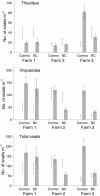Use of black carp (Mylopharyngodon piceus) in biological control of intermediate host snails of fish-borne zoonotic trematodes in nursery ponds in the Red River Delta, Vietnam
- PMID: 23680382
- PMCID: PMC3659103
- DOI: 10.1186/1756-3305-6-142
Use of black carp (Mylopharyngodon piceus) in biological control of intermediate host snails of fish-borne zoonotic trematodes in nursery ponds in the Red River Delta, Vietnam
Abstract
Background: The risks of fish-borne zoonotic trematodes (FZT) to human health constitute an important problem in Vietnam. The infection of humans with these trematodes, such as small liver trematodes (Clonorchis sinensis and Opisthorchis viverrini), intestinal trematodes (Heterophyidae) and others is often thought to be linked to fish culture in areas where the habit of eating raw fish is common. Juvenile fish produced in nurseries are often heavily infected with FZT and since fishes are sold to aquaculture facilities for growth, control of FZT in these fishes should be given priority. Controlling the first intermediate host (i.e., freshwater gastropods), would be an attractive approach, if feasible. The black carp, Mylopharyngodon piceus, is a well-known predator of freshwater snails and is already used successfully for biological control of snails in various parts of the world including Vietnam. Here we report the first trials using it for biological control of intermediate host snails in nursery ponds stocked with 1-week old fry (10-12 mm in length) of Indian carp, Labeo rohita.
Methods: Semi-field and field experiments were set up to test the effect of black carp on snail populations. In the semi-field experiment a known quantity of snails was initially introduced into a pond which was subsequently stocked with black carp. In the field trial in nursery ponds, density of snails was estimated prior to a nursing cycle and at the end of the cycle (after 9 weeks).
Results: The results showed that black carp affect the density of snail populations in both semi-field and field conditions. The standing crop of snails in nursery ponds, however, was too high for 2 specimens to greatly reduce snail density within the relatively short nursing cycle.
Conclusions: We conclude that the black carp can be used in nursery ponds in Northern Vietnam for snail control. Juvenile black carp weighing 100 - 200 g should be used because this size primarily prey on intermediate hosts of FZT and other studies have shown that it does not prey on fish fry of other species. It may be necessary to use a high stocking density of black carp or to reduce snail density in the nursery ponds using other measures (e.g. mud removal) prior to stocking fry in order for the black carp to keep the density of intermediate host snails at a very low level.
Figures


Similar articles
-
Relationship between snail population density and infection status of snails and fish with zoonotic trematodes in Vietnamese carp nurseries.PLoS Negl Trop Dis. 2012;6(12):e1945. doi: 10.1371/journal.pntd.0001945. Epub 2012 Dec 20. PLoS Negl Trop Dis. 2012. PMID: 23285303 Free PMC article.
-
Effect of pond water depth on snail populations and fish-borne zoonotic trematode transmission in juvenile giant gourami (Osphronemus goramy) aquaculture nurseries.Parasitol Int. 2015 Dec;64(6):522-6. doi: 10.1016/j.parint.2015.07.005. Epub 2015 Jul 21. Parasitol Int. 2015. PMID: 26209455
-
Distribution of freshwater snails in family-based VAC ponds and associated waterbodies with special reference to intermediate hosts of fish-borne zoonotic trematodes in Nam Dinh Province, Vietnam.Acta Trop. 2010 Oct;116(1):15-23. doi: 10.1016/j.actatropica.2010.04.016. Epub 2010 May 10. Acta Trop. 2010. PMID: 20457118
-
Control methods for snail-borne zoonoses.J Wildl Dis. 1970 Oct;6(4):262-5. doi: 10.7589/0090-3558-6.4.262. J Wildl Dis. 1970. PMID: 16512124 Review.
-
[Role of gastropods in epidemiology of human parasitic diseases].Wiad Parazytol. 2001;47(1):3-24. Wiad Parazytol. 2001. PMID: 16888946 Review. Polish.
Cited by
-
Current status of fish-borne zoonotic trematode infections in Gia Vien district, Ninh Binh province, Vietnam.Parasit Vectors. 2015 Jan 13;8:21. doi: 10.1186/s13071-015-0643-6. Parasit Vectors. 2015. PMID: 25586313 Free PMC article.
-
Histopathological changes in tissues of Bithynia siamensis goniomphalos incubated in crude extracts of camellia seed and mangosteen pericarp.Korean J Parasitol. 2013 Oct;51(5):537-44. doi: 10.3347/kjp.2013.51.5.537. Epub 2013 Oct 31. Korean J Parasitol. 2013. PMID: 24327779 Free PMC article.
-
Current status and perspectives of Clonorchis sinensis and clonorchiasis: epidemiology, pathogenesis, omics, prevention and control.Infect Dis Poverty. 2016 Jul 6;5(1):71. doi: 10.1186/s40249-016-0166-1. Infect Dis Poverty. 2016. PMID: 27384714 Free PMC article. Review.
-
Haematopoiesis in molluscs: A review of haemocyte development and function in gastropods, cephalopods and bivalves.Dev Comp Immunol. 2016 May;58:119-28. doi: 10.1016/j.dci.2015.11.010. Epub 2015 Nov 22. Dev Comp Immunol. 2016. PMID: 26592965 Free PMC article. Review.
-
Three reasons why expanded use of natural enemy solutions may offer sustainable control of human infections.People Nat (Hoboken). 2022 Feb;4(1):32-43. doi: 10.1002/pan3.10264. Epub 2021 Oct 7. People Nat (Hoboken). 2022. PMID: 35450207 Free PMC article.
References
-
- Sen-Hai Y, Mott KE. Epidemiology and morbidity of food-borne intestinal trematode infections. 1994. WHO/SCHISTO/94.108 1994 26pp.
-
- Mas-Coma S, Bargues MD. Human liver flukes: a review. Res Rev Parasitol. 1997;57(Suppl 3–4):145–218.
Publication types
MeSH terms
LinkOut - more resources
Full Text Sources
Other Literature Sources
Research Materials

